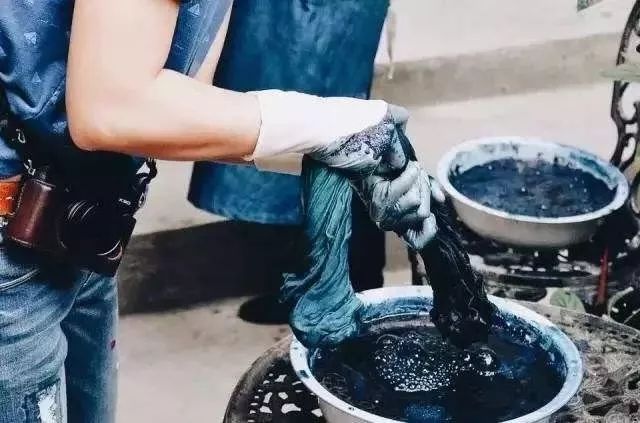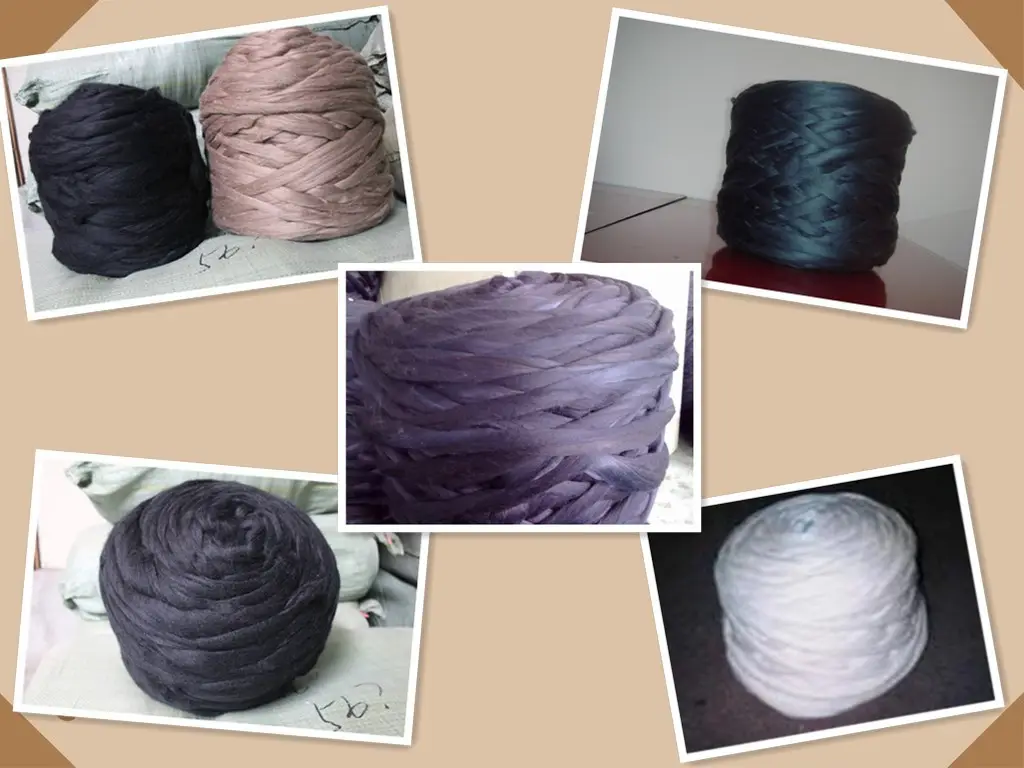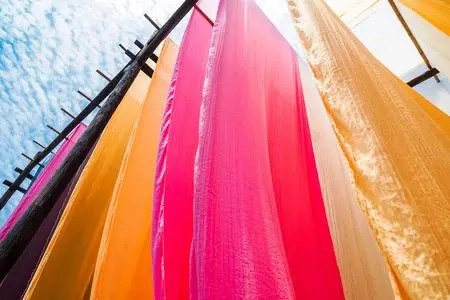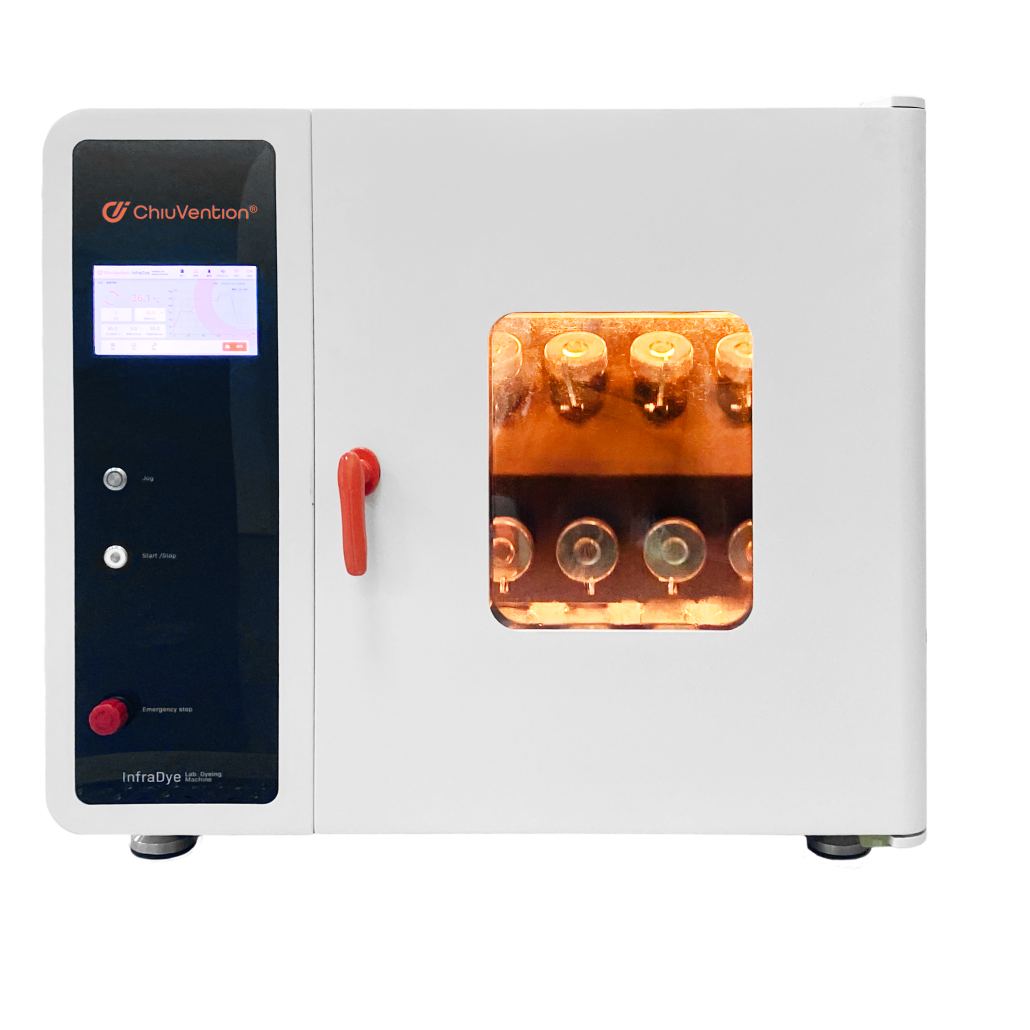Textile dyeing changes the color of fibres or fabrics. It happens by immersing them in a dye solution. It is widely used. Dyeing adds color to fabrics or yarns. It makes textiles more valuable.
Textile Dyeing Methods
Different methods of dyeing classify dyeing as dip-dyeing and tie-dyeing.
Dip-dyeing
Principle
Dip-dyeing is a dyeing method. Fabrics soak in dye for a specific period. The dye stains and fixes in the fibres.
Method
Dip-dyeing methods include immersion, stirring, spraying, tumbling and penetration.
Scope of application
Dip-dyeing is for dyeing loose fibres, yarns, and knitted, silk, and velvet fabrics. It is also for thin, woolen, and mesh fabrics. It’s for other dyed materials that can’t withstand tension or rolling.
Characteristics
It is suitable for dyeing many textile forms. The production is intermittent and less efficient. But, the equipment is simpler and easier to use.
Rolling and dyeing
Principle
It is the process of soaking the fabric in dye and then rolling it with rollers to push the dye into the gaps in the fabric. At the same time, this squeezes out extra dye. This makes the dye spread evenly on the fabric. Then, the dye attaches to the fibers after steam or baking and other finishing steps.
Method
In order to achieve an even dyeing effect, the liquid must roll evenly. Generally, there are several forms of dipping and rolling. There is one kind, one more kind, two kinds, and more. The kind to use depends on fabrics, equipment, dyestuffs, and so on.
Scope of application
Usually, roll dyeing dyes woven fabrics. But, it also dyes silk bundles and yarns. However, fabrics that can’t withstand tension or pressure should not be roll dyed. Roll dyeing is suitable for dyeing large quantity of fabrics.
Characteristics
It is a continuous dyeing process with high efficiency. It is suitable for dyeing large quantities of textile fabrics. But, the dyed objects are subject to greater tension. It is usually used for dyeing woven fabrics.
The links are in production and processing. You can split them into the original liquid dyeing. Plus, fibre, wool, yarn, and pi dyeing. They also include garment dyeing.
Loose fibre dyeing
The dyeing of fibers or loose fibers before spinning happens in large dye vats. Applying the dye at the right temperatures. Dyers use loose fiber dyeing to color-spin most of the yarns. There is also the effect of single dyeing of different fibers. This type of dyeing is common in worsted woolen fabrics.
Wool strip dyeing
This also belongs to dyeing fibre before it becomes yarn. It has the same purpose as bulk fibre dyeing: to get a soft mixed-color effect. Stripe dyeing is generally used for combed wool yarns and wool fabrics.
Yarn dyeing
Before weaving, dyers dye yarns. This is mainly for woven textiles and sweaters. Or for yarns used directly, like sewing threads. Yarn dyeing is the basis of dyeing and weaving. There are three conventional methods of yarn dyeing:
① Stranded yarn dyeing – loose stranded yarn is dipped in a special dyeing vat, which is a costly dyeing method;
② For cylinder dyeing, the yarn is wound on a perforated cylinder. Many cylinders are then loaded into the dyeing vat. The dyeing liquid circulates and flows. But, the fluffy and softness are not as good as with stranded yarn dyeing.
③ Warp beam dyeing is a kind of large-scale rolled dyeing. It dyes woven fabrics before making them. The workers make them into the warp beam (warping). Dye colors the entire warp yarn. For example, the joint pulp dyeing machine dyes the warp yarn bundle. Because it is the warp beam, so more suitable for woven fabric dyeing use. But with the rise of the warp beam drop tube, we can make yarn on the warp beam into tube yarn after dyeing. A wider range uses this kind of dyed yarn. For example, indigo dyeing mostly uses reduction dyeing. Only warp beam dyeing can solve this. Without the warp beam drop tube, it is very hard to achieve.
Pie Dyeing
They call the method of dyeing the woven fabric blanks Pi-dyeing. The common methods are rope dyeing, jet dyeing, roll dyeing, and warp beam dyeing. Rolling dyeing is also common, but it is not tie-dyeing.
Garment Dyeing
Semi-bleached fabrics are first made into clothes. The clothes are then put into nylon bags. Bags load into the dyeing vat and agitate them. Garment dyeing is mainly for knitted hosiery, T-shirts, and most other knitted garments. It also works for sweaters, trousers, shirts, and some other simple garments.
Dyeing Firmness
Dyeing fastness refers to the dye’s ability to keep its color. It must do so despite various external factors in the dyeing process. Dyeing fastness is one of the important indicators of dyeing product quality. There are many kinds of dyeing fastness. The kind depends on the use of the dyed products and the processing technology. They include: color fastness to sunlight, washing, perspiration, and friction. Also, sublimation, ironing, bleaching, acid, and alkali. There are also sea-water fastness and smoke fastness for special products.
Dyeing process
Dyeing in a conventional plant has three stages:
Adsorption
Adsorption is the process by which the dye attaches to the surface of the fiber. The fiber adsorbs the dye from the solution due to forces between molecules and between ions.
Diffusion and penetration
After adsorption, the dyestuff must enter the fiber and stay inside. It diffuses from the surface to the interior and enters the fiber’s amorphous zone. This happens until the dye’s concentration inside and outside the fiber are equal.
Fixation
This is a key process for good dyeing fastness. The dye enters the fibre’s amorphous zone. It links to the fiber’s molecules by chemical force. This force can be ionic or covalent. It also links by gravity between molecules (van der Waals force). It also links by hydrogen bonding. These bonds give the dye a certain degree of fastness.
In actual dyeing, the above three stages cannot be distinctly distinguished. The dyeing process varies with different dyes, different fibres and different dyeing processes.
Laboratory sample dyeing is the process of dyeing textile samples in a lab. It uses dyeing equipment and scientific methods. Before making dyes and textiles, we dye them. The process tests the dyeing effect. It finds the best dyeing formula and makes color matches and adjustments. Dyeing samples in the laboratory helps textile makers and dye suppliers. It lets them do the needed tests and tweaks before large-scale production. This makes sure the color of the final product meets the standards. The standards are for consistency and quality.
Laboratory Sample Staining Procedure
Sample Preparation
We analyze textile samples to understand their fiber, fabric, and surface. We then select suitable samples and prepare dyestuffs to make a dyeing solution.
Sample dyeing
This is the main stage of the dyeing process and includes immersion dyeing and rolling. The cups are automatically reversed. This ensures dyeing is even and prevents pigment from sticking and stringing. After dyeing the samples, we check them for color matching. This includes comparing them to the original samples. We aim to determine whether we have achieved the desired color effect.
Temperature control
The temperature should be 80-100°C. The time should be 30-60 minutes. This is what the dyeing demand requires. In general, you should adjust it to suit the actual situation. This ensures the best dyeing.
Post-treatment
After dyeing, we need to do post-treatment work. This includes rinsing and drying to improve the color fastness.
Laboratory Sample Dyeing Equipment
To reduce dyeing errors, textile makers need to test dyeing samples. They should do this before dyeing large amounts. The InfraDye Smart Dyeing Sampler dyes fabric, yarn, and loose fiber samples. It mimics on-site production. This enables fast, low-cost dyeing samples. The sampler is great for dyeing factories and color matching labs. It’s also good for matching colors in printing and dyeing factories. It’s also good for dye research in fabric dyeing labs.
The algorithm is for smart temperature control. It works for many temperatures, from room temperature to high temperature dyeing.
One time can achieve many dyeing solutions. Each cup can do a different specimen dyeing.
Smart networking can monitor the machine test status from afar. It can give alerts for problems.
Factors affecting the dyeing effect
Influence of dye concentration
Take dyeing blue as an example. It will show the influence of dye solution concentration. When dyeing, the dyeing solution’s concentration affects dye absorption. When the dye concentration increases, there is a maximum limit to the amount of dye absorbed. In general, we base the dye amount on the weight of the plastic and the bath ratio.
Influence of dyeing temperature
Take dyeing blue colouring for 3min as an example to see the effect of temperature on the colouring rate. In general, higher dyeing temperature increases the kinetic energy of the dye particles. It also increases the pores inside the plastic. This improves dye dispersion, which helps dye adsorption and diffusion. It also increases dyeing speed. If the temperature is too high, it will make the dyed dye re-dissolve into the dye solution. This will decrease the colouring rate. So, controlling the temperature is key when dyeing.
Influence of dyeing time
The dyeing time affects the size of the dye absorption rate. Take dyeing blue colour (85℃) as an example. Colouring rate goes up with time. If the time is too short, dye can’t reach equilibrium. Absorption is not enough. At this time, you can add dyeing aid to help. No, it can’t meet the product’s requirement. So, we must strictly control the dyeing time.
The influence of electrolyte
Electrolyte has a great influence on dyeing. The right electrolyte concentration speeds dyeing. But, too much will ruin the gel and make the dye precipitate. This hurts the dyeing.
Influence of the condition of plastic before dyeing
The oil on the plastic’s surface will affect the dyeing’s color. It will make the color dull and lacking gloss. Therefore, you must clean it before dyeing. Plastics contain additives like plasticiser, lubricant, and anti-static agent. These also influence dyeing.
For more information on textile testing methods/standards
or textile testing machines, contact us:
What’s App: +86 180 2511 4082
Tel: +86 769 2329 4842
Fax: +86 769 2329 4860
Email: medium@chiuvention.com



